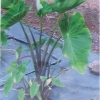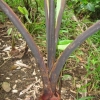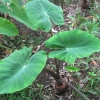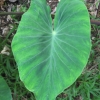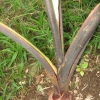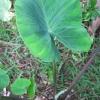Use As Food
A common poi taro; also considered an excellent table variety, and the leaves are popular for lū ‘au. Goup piko are known to make good poi.
Distribution
Grown either as lo‘i (wetland) or māla (upland) taro; planted quite extensively at Kona, Hawaii. According to Earl Kawa‘a, on 8/30/10, this variety was planted extensively in Hālawa, Moloka‘i.
General Characteristics
Medium in height, erect, moderately stocky, maturing within 12 to 15 months, producing from 5 to 10 ‘ohā; distinguished from other Piko taros by the dark purplish Hā (Petiole).
Ha (Petiole)
55 to 85 cm. long, reddish-brown to purplish, especially on lower half, with indistinct or narrow reddish edge and usually with adjacent dark green blotches, particularly near the kōhina (base), a brilliant dark pink ring at the kōhina (base) with light pink area flecked with light reddish-brown for 3 to 4 cm. above the base.
Lau or Lu'au(Leaf Blade)
35 to 45 cm. long, 20 to 30 cm, wide, 20 to 30 cm. from tip to base of sinus (māwae), horizontal broadly arrow head shaped leaf tapering abruptly to a sharp point; fairly firm in texture. Dark green color; piko light green to light pinkish; round leaf section (lobes) obtuse with narrow lihi māhae (sinus).
'I'o kalo (Corm)
Flesh white with pinkish tinge, especially near apex, and yellowish fibers; skin pale salmon-pink, often purple along leaf-scar rings.
Pua (Flower)
Hā (peduncle) reddish-purple; flower cover (spathe) 15 to 20 cm. long, the lower tubular constricted portion 3 to 4.5 cm. long, green, tinged with red at base, usually partially open exposing the ovaries, the upper portion deep yellow; spadix 5 to 6 cm. long, the sterile appendage about 4 mm. long.
Remarks
Taro of this family are very tough with a resistance to root rot. Piko ‘Ele‘ele does better in the upper valley areas where rainfall is abundant and the water cool; at low elevations in water which has become warm by passing through several paddies a soft starch is produced which rots readily. The name Piko ‘Ele‘ele is sometimes confused with Pikoele; the latter is not a Piko taro.

